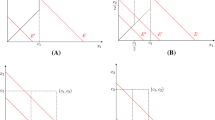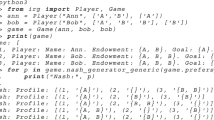Abstract
Commitment among agents is always difficult, especially when a scarce resource is to be shared. On the one hand, there are many possible ways to assign the available amount; on the other hand, each agent is motivated to propose a distribution that maximizes her award. In this paper, we propose a mechanism that combines the diminishing claims (Chun in Math Soc Sci 17(3):245–261, 1989) and the unanimous concessions (Herrero in Advances in economic design. Springer, Berlin, 2003) procedures, thereby obtaining a new justification of rules based on averaging.
Similar content being viewed by others
Notes
The Talmud rule (Aumann and Maschler 1985) assigns the awards that \(CEA\) recommends for \((E, c/2)\), when the endowment is less than the half-sum of the claims. Otherwise, each agent receives her half-claim plus the amount provided by \(CEL\) when it is applied to the residual problem \((E-C/2,c/2)\).
References
Arin J (2007) Egalitarian distributions in coalitional models. Int Game Theory Rev 9(1):47–57
Aumann RJ, Maschler M (1985) Game theoretic analysis of a bankruptcy from the Talmud. J Econ Theory 36:195–213
Bosmans K, Lauwers L (2011) Lorenz comparisons of nine rules for the adjudication of conflicting claims. Int J Game Theory 40:791–807
Chun Y (1989) A noncooperative justification for egalitarian surplus sharing. Math Soc Sci 17(3):245–261
Chun Y, Thomson W, Schummer J (2001) Constrained Egalitarianism: a new solution to bankruptcy problems. Seoul J Econ 14:269–297
Gadea-Blanco P, Giménez-Gómez JM, Marco-Gil MC (2010) Some game-theoretic grounds for meeting people half-way. IVIE. Working Papers, Serie AD 04
Garcia-Jurado I, Gónzalez-Villar A (2006) A non-cooperative approach to bankruptcy problems. Span Econ Rev 8:189–197
Giménez-Gómez JM, Marco-Gil MC (2008) A new approach for bounding awards in bankruptcy problems. IVIE. Working Papers, Serie AD 07
Giménez-Gómez JM, Peris JE (2011) An axiomatic justification of mediation in bankruptcy problems. CREIP, Working Papers 18
Herrero C (2003) Equal awards versus equal losses: duality in bankruptcy problems. In: Sertel MR, Koray S (eds) Advances in economic design. Springer, Berlin, pp 413–426
Herrero C, Villar A (2001) The three musketeers: four classical solutions to bankruptcy problems. Math Soc Sci 42(3):307–328
Lorenz M (1905) Methods of measuring the concentration of wealth. Publ Am Stat Assoc 9:209–219
Marco-Gil MC, Peris JE, Subiza B (1995). A mechanism for meta-bargaining problems. IVIE. Working Papers. Serie AD 98–17
Piniles HM (1861) Drkah shel Torah. Forester Edition, Viena
Rawls J (1971) A theory of justice. Belknap/Harvard, Cambridge
Sprumont Y (1991) The division problem with single-peaked preferences: a characterization of the uniform allocation rule. Econometrica 6:19–31
Thomson W (2003) Axiomatic and game-theoretic analysis of bankruptcy and taxation problems: a survey. Math Soc Sci 45(3):249–297
Thomson W (2007). On the existence of consistent rules to adjudicate conflicting claims: a constructive geometric approach. Rev Econ Des 11(3):225–251
Thomson W, Yeh C (2008) Operators for the adjudication of conflicting claims. J Econ Theory 143(1): 177–198
van Damme E (1986) The Nash bargaining solution is optimal. J Econ Theory 38:78–100
Acknowledgments
We are particularly grateful to two anonymous referees and the Editor for many valuable comments and suggestions that have led to a substantial improvement in the manuscript. We would like to thank Josep E. Peris, María C. Marco-Gil and congress participants of XXXII SEIO for their very useful comments. Financial support from Universitat Rovira i Virgili, Banco Santander and Generalitat de Catalunya under project 2011LINE-06 and the Barcelona GSE are gratefully acknowledged. The usual caveats apply.
Author information
Authors and Affiliations
Corresponding author
Appendix
Appendix
Proof of Theorem 1
The proof of this result is based on a fact, two lemmas and a remark.
Fact 1
By the definition of the double concessions procedure, it can be easily seen that, for any \(P\)-admissible rule, the weakly dominant strategies for the smallest and the highest claimant are dual. In other words, if the weakly dominant strategy for the smallest claimant is \(f\), then the weakly dominant strategy for the highest agents will be \(f^{d}\), and vice versa.
The first lemma shows that, in any step \(m\in \mathbb N \), \(m>1\), the sum of minimum and maximum amounts recommended by these rules coincides with the sum of the claims.
Lemma 1
For each \((E,c)\in \mathcal B \) and each \(i\in N\), such that \(\varphi ^{i} \in \Phi (P,f)\),and \(m\in \mathbb N ,m>1\),
Proof
Let each \((E,c)\in \mathcal B \) and each \(i\in N\), such that \(\varphi ^{i} \in \Phi (P,f)\) and \(m\in \mathbb N ,m>1\). Then, \(s_{i}(E,c)=\min \left\{ f_{i}\left( E,c\right) ,f^{d}_{i}\left( E,c\right) \right\} \), and \(ce_{i}(E,c)=\max \left\{ f_{i}\left( E,c\right) ,f^{d}_{i}\left( E,c\right) \right\} \).
By duality, for each agent we are adding \(f\) and \(f^{d}\) rules. Hence, the next expression comes straightforwardly
Finally, we know that
by the definition of the double concessions procedure.\(\square \)
The following remark is a direct consequence of Lemma 1 and it states that for each claims problem at any step \(m\in \mathbb N ,m>1\), the half of the claims sum at every step of the double concessions procedure coincides with both the endowment and the total loss at every step of the process.
Remark 1
For each \((E,c)\in \mathcal B \) and each \(i\in N\), such that \(\varphi ^{i} \in \Phi (P,f)\) and \(m\in ,m>1\), \(E^{m}=L^{m}=C^{m}/2\).
Proof
Let each \((E,c)\in \mathcal B \) and each \(i\in N\), such that \(\varphi ^{i} \in \Phi (P,f)\) and \(m>1\in \mathbb N \). We know that, \(L^{m}=C^{m}-E^{m}\). By Lemma 1, \(E^{m}=C^{m}/2\). Therefore, \(L^{m}=C^{m}-C^{m}/2=C^{m}/2\). \(\square \)
Finally, the next lemma states that each agent’s claim at each step, different from the initial one, coincides with the sum of both the minimum and the maximum amounts recommended by these two focus.
Lemma 2
For each \((E,c)\in \mathcal B \) and each \(i\in N\), such that \(\varphi ^{i} \in \Phi (P,f)\) and \(m>1\in \mathbb N \),
Proof
Let each \((E,c)\in \mathcal B _{P}\) and each \(i\in N\), such that \(\varphi ^{i} \in \Phi (P,f)\) and \(m>1\in \mathbb N \), by Remark 1 we know that for \(m>1\in \mathbb N \), \(L^{m}=E^{m}\), so, \(s_{i}(E^{m},c^{m})=s_{i}(\left( L^{m},c^{m}\right) ^{d})\). By duality \(ce_{i}(E^{m},c^{m})=c_{i}^{m}-s_{i}(\left( L^{m},c^{m}\right) )=c_{i}^{m}-s_{i}(E^{m},c^{m})\), then, \(c_{i}^{m}=ce_{i}(E^{m},c^{m})+s_{i}(E^{m},c^{m})\). \(\square \)
Proof of Theorem 1
Let \((E,c)\in \mathcal B \) such that \(\varphi ^{i} \in \Phi (P,f)\), for each \(i\in N\), and each \(m\in \mathbb N \), given that \(\psi =(\varphi ^1,\varphi ^2,\dots ,\varphi ^n)\),
By the definition of the double concessions procedure
By Lemma 2,
Hence,
Thus,
Therefore, by Fact 1
\(\square \)
Rights and permissions
About this article
Cite this article
Giménez-Gómez, JM. A Way to Play Claims Problems. Group Decis Negot 23, 617–627 (2014). https://doi.org/10.1007/s10726-013-9347-5
Published:
Issue Date:
DOI: https://doi.org/10.1007/s10726-013-9347-5




